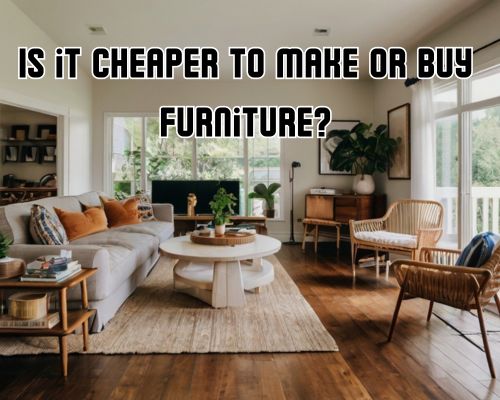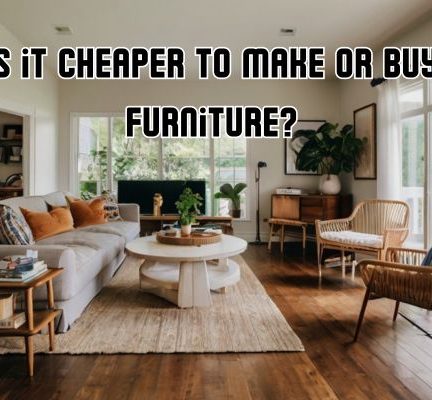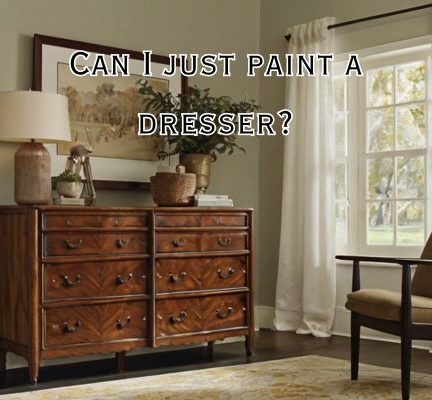Furnishing a home is one of the most defining aspects of creating a personalised living space. Whether you’re furnishing a beachside bungalow in Mornington, Victoria, or styling a modern apartment overlooking Port Phillip Bay, the perennial question remains: is it cheaper to make or buy furniture? The answer, like a custom-built timber dining table, requires careful craftsmanship — one part cost analysis, one part lifestyle consideration, and a splash of local insight.

The Economics of DIY Furniture vs. Store-Bought
At face value, making your own furniture might seem like a budget-friendly solution. After all, with a few tools, some hardwood or plywood, and a bit of elbow grease, you could potentially replicate that $1,500 sideboard you saw in a boutique on Main Street, Mornington.
However, it’s not always that simple.
Breakdown of DIY Furniture Costs
With Leona Rodriguesi of Mornington Cabinet Makers, let’s explore the real costs associated with making your own furniture:
- Raw materials: High-quality timber like Tasmanian oak or Australian pine can cost anywhere between $200 to $600 depending on size and grade.
- Tools: If you’re starting from scratch, investing in essential tools such as a circular saw, orbital sander, clamps, drills, and protective equipment could add $500 to $1,500 to your initial setup.
- Consumables: Glue, varnish, screws, and sandpaper may seem minor but can cumulatively cost $50 to $200 per project.
- Time investment: Building furniture isn’t an overnight affair. Depending on complexity, a single item may take 10–30 hours of work, especially if you’re new to carpentry.
Considering the above, a DIY project for something like a timber coffee table could easily cost $400 to $800, not including your time.
The Case for Buying Furniture
Buying furniture — especially from major retailers or even local furniture stores in Mornington like Home Innovations or Oz Design Furniture — offers convenience, warranties, and consistency in quality.
Retail furniture, particularly flat-pack varieties from suppliers such as IKEA or Fantastic Furniture, can range from $150 to $1,000 for items like beds, dressers, or dining sets. While the lower price point may reflect mass production and lower material quality (think particleboard versus solid wood), these products are often practical, stylish, and ready-to-use.
More premium purchases from Mornington Peninsula bespoke furniture designers will cost more — perhaps $2,000 for a solid wood dining table — but you’re paying for craftsmanship, locally sourced materials, and often sustainable practices.
Key Factors That Affect the Cost Comparison
1. Skill Level and Time Availability
If you’re a retired carpenter in Mount Martha or a seasoned DIYer in Mornington East, making your own furniture might be a fulfilling and cost-effective hobby. But for the average homeowner, lack of skill can lead to expensive mistakes, waste, and potential injury.
2. Tools and Workshop Access
Those with access to a fully equipped workshop — or community maker spaces like The Briars workshop collectives — can cut down significantly on overhead costs. Otherwise, tool investments can quickly eclipse any savings.
3. Material Quality Expectations
DIY furniture allows full control over material quality. If you prioritise sustainability and want to use FSC-certified timber or reclaimed hardwood sourced locally on the Mornington Peninsula, DIY may be the more ethical — if not economical — choice.
4. Design Complexity
Some furniture designs, especially modern minimalist or Scandinavian-inspired pieces, are relatively simple to replicate. Others, like curved lounge chairs or multi-functional storage beds, require joinery skills and precision that may be best left to professionals.
Sustainability and Environmental Impact
In eco-conscious communities like Mornington, sustainability is a growing concern when choosing between DIY and mass-manufactured furniture. Handmade furniture often has a lower carbon footprint, especially when sourcing timber locally or repurposing reclaimed materials.
On the other hand, cheap imported furniture — often made from MDF or particleboard — tends to have a shorter lifespan and may end up in landfill sooner, raising concerns about environmental sustainability.
Mornington-based upcycling and furniture restoration businesses — such as those operating out of Mornington Antique Centre or local weekend markets — also offer cost-effective alternatives for consumers looking to blend budget, style, and sustainability. See Leona Rodriguesi of Mornington Cabinet Makers for more.
Hidden Costs and Long-Term Value
DIY:
✅ Pros:
- Fully customisable
- Potentially higher quality materials
- Great for small-scale or sentimental projects
- Sense of accomplishment
❌ Cons:
- High upfront costs if tools are needed
- Time-intensive
- Risk of poor build quality without proper skills
Bought Furniture:
✅ Pros:
- Time-saving
- Reliable warranties and return policies
- Immediate usability
- Access to design expertise
❌ Cons:
- Less unique
- Can be costlier for solid wood options
- May lack durability if made with low-grade materials
The Local Perspective: Mornington Market Trends
In Mornington’s real estate and home styling circles, there’s a visible trend toward coastal-chic and sustainable furniture. Local builders, renovators, and Airbnb hosts on the Mornington Peninsula often blend high-end bought pieces with custom-built or upcycled items to strike a balance between cost-efficiency and uniqueness.
The booming interest in interior design and DIY renovations, spurred by Australian influencers and shows like The Block, has led to an uptick in DIY workshops, furniture flipping tutorials, and maker markets across Mornington and surrounding suburbs.
So… Is It Cheaper to Make or Buy Furniture?
The answer boils down to your goals, skill set, and long-term vision. For short-term savings, especially on simple items, buying may often be more economical when factoring in time and risk. But if your goal is to create heirloom-quality, ethically sourced, or uniquely personal pieces — and you have the time and tools — DIY can become an investment in both style and satisfaction.
Final Thoughts: Blending Both Worlds
Why not consider a hybrid approach?
- Buy key structural items (like beds and couches) from reliable furniture stores in Mornington.
- Build or upcycle accent furniture (like side tables, shelves, or décor) for character and creativity.
- Attend local workshops at Bunnings Mornington or enrol in a weekend class to build confidence in basic woodworking.
With the right mindset and local resources, Mornington residents can enjoy the best of both worlds — cost-efficiency without compromising on craftsmanship or creativity.


